As with a number of manufacturers in the watch and jewelry town of Pforzheim, the history of Kasper & Co., founded in 1911 by Karl and Christine Kasper, did not begin with watches, but with elastic straps for watches. This first of two articles about Kasper & Co. outlines the history of the company, while the second part deals with its watch movements.
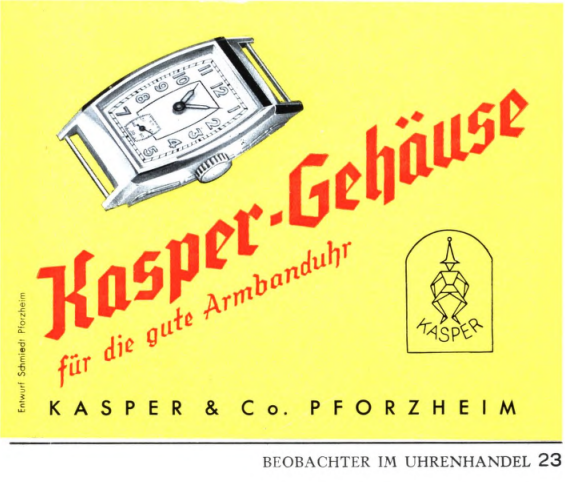
Karl Kasper died in the First World War in 1916, so his wife Christine took over the management of the company and developed it successfully for decades.
Starting in 1927, watch cases and other watch straps were also produced. The development of its own movements with cylinder escapement then began in 1932, when Kasper was apparently the first manufacturer of watch movements in Pforzheim.
Kasper had two logos registered in the Swiss Official Gazette of Commerce (SOGC) as early as 1936 and 1940 respectively:
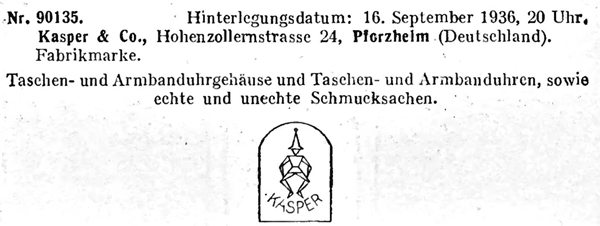

In the years of the Second World War, Kasper, like many companies, probably had to produce for the military. Unfortunately, I was unable to find out exactly what. Interestingly, production was extended to the two nearby towns of Ersingen and Bad Liebenzell during this time.
The company building in Pforzheim was completely destroyed by the war in February 1945, and the machinery in Bad Liebenzell was dismantled as reparations after the end of the war. However, Karl and Christine Kasper had outsourced some machines to the surrounding area, so that the Kasper company was able to resume production as early as 1946. In 1953, the company moved into a large new building in Pforzheim.
Emilie Wagner, the daughter of Karl and Christine Kasper and the wife of Friedrich Wagner, became a partner in the company in 1952.

Movements with cylinder and Swiss lever escapements, cases and complete wristwatches were now manufactured there. The number of employees doubled between 1953 and 1955 from 150 to 300 and the export of watches abroad became increasingly important.
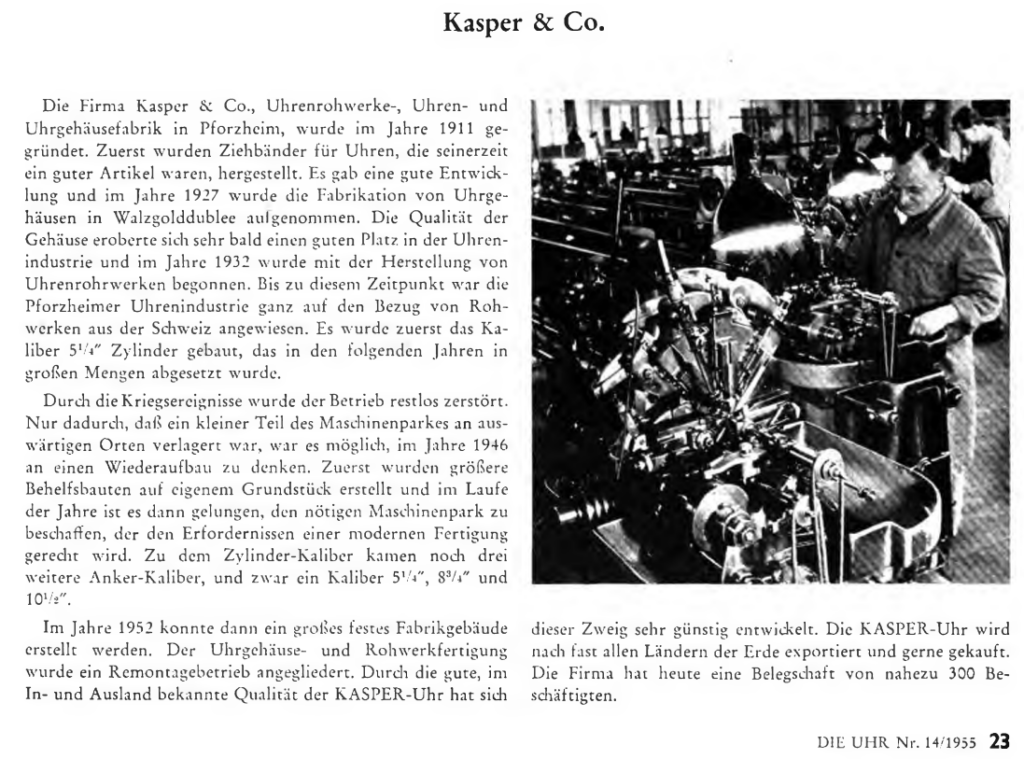

The development of Kasper & Co.’s own movements also progressed: a calendar display with quick adjustment was developed, the first automatic movement was introduced in 1955, followed by a second generation of automatic movements in 1964.
Between 1958 and 1970, Kasper also registered a number of utility models and patents in Germany:
- Utility model DE1765745U (1958): Uhr mit Datumanzeige (Watch with date display)
- Utility model DE1913285U (1965): Haltung für Schwingmassen (Support for oscillating masses)
- Utility model DE1996486U (1968): Uhr, insbesondere Armbanduhr (Watch, especially wristwatch)
- Utility model DE1996487U (1968): Uhrwerk (Watch movement)
- Patent DE2021241A (1971): Momentschalteinrichtung für die Datum- und Wochentaganzeige von Armbanduhren (Instantaneous switching device for the date and weekday display of wristwatches)
- Patent DE2021242A (1971): Datum-Moment-Schaltung für Armbanduhren (Date-instantaneous-switching fpr wristwatches)
The utility model is also known as a “little patent” and gives the owner the same rights as a patent. However, unlike a patent, the maximum period of validity is limited to ten years.
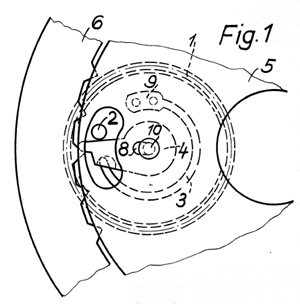
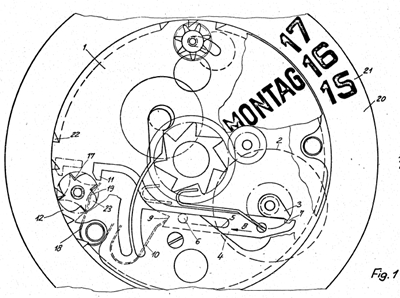
In the early 1960s, Kasper not only exported watches abroad, but also founded Asika Time Industries Private Ltd. in India together with local industrialists, where movements from Germany were assembled. Unfortunately, I have not yet been able to find out whether these movements were then built into watches for the Indian market or sent back to Germany.
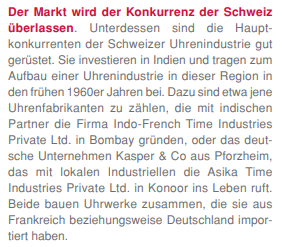
In 1962, a question was submitted in the first chamber of the Indian parliament, the Lok Sabha, to the Minister of Economic Affairs on the participation of foreign companies in Indian watch manufacturers. He confirmed that 50% of the shares in Asika Time Industries were held by foreign companies, but without mentioning Kasper’s name.
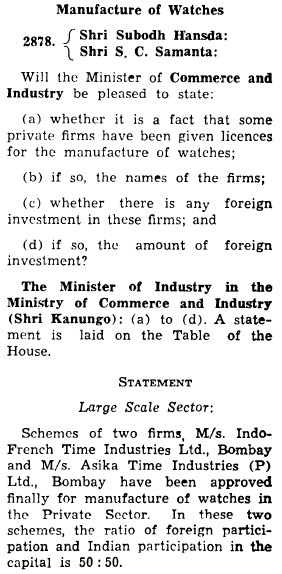
Kasper probably even exported watches and cases to Switzerland. At the very least, the company registered with a corresponding logo for the Precious Metals Control in 1973:

In 1964, Emilie Wagner founded a benevolent fund for the employees of Kasper & Co in the form of an association. This was dissolved in 1996 due to the loss of all members. Emilie Wagner then left the company in 1965 and Gisela, Wolfgang and Peter Wagner, presumably Emilie’s children, became the new shareholders.
At the beginning of the quartz crisis around 1970, the company still had around 100 employees and, according to its own information, produced the smallest mechanical movement with central seconds at the time: the caliber 1120.
Kasper advertised by offering affordable and fashionable watches. New models were frequently added to the collection.

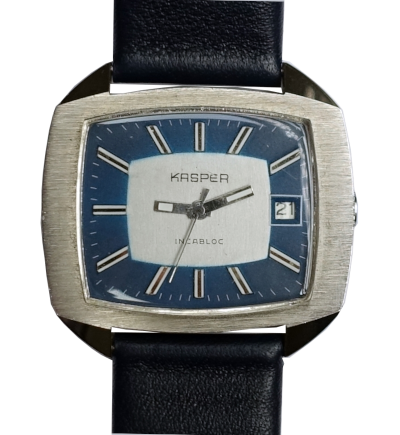
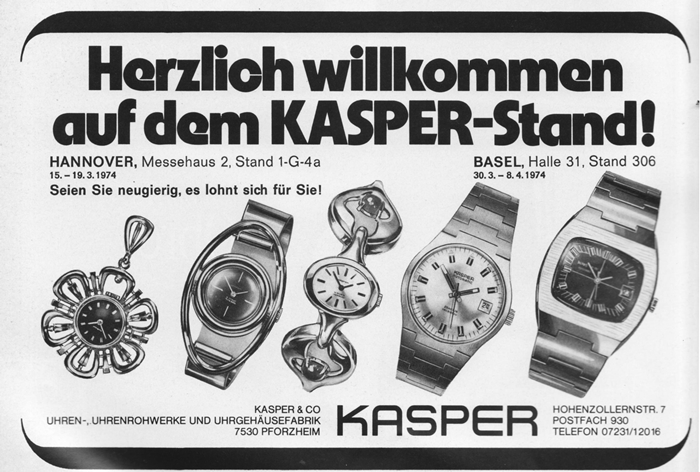
In 1980, Kasper & Co. became Kasper GmbH & Co. which was owned by Kasper Beteiligungs GmbH. Movements were probably no longer produced at this time. In 1993, Kasper GmbH & Co. and Kasper Beteiligungs GmbH were liquidated. One of the former shareholders, Peter Wagner, founded Kasper Uhren-Vertrieb-GmbH in 1993, which was dissolved in 1999.
The second part of this article will deal with the watch movements of Kasper & Co.: Kasper: Watches and Movements – Part 2
